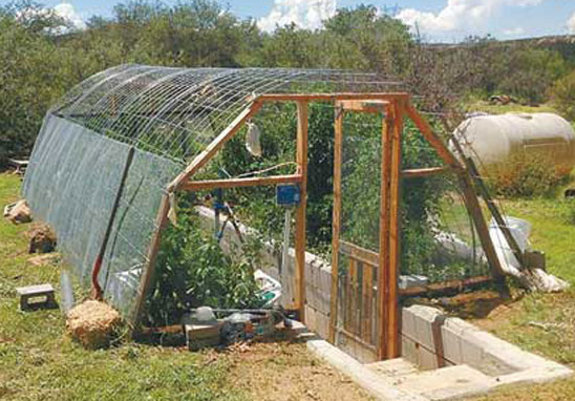
Cattle panel underground greenhouse

We've had good luck extending
the growing season with our quick
hoops.
If we keep moving towards a mini Ice Age Dean Steward's cattle
panel greenhouse with the
cinder block basement might be a good direction to consider.
Seems like it could also incorporate some additional diy
geothermal energy to keep things from freezing in the Winter and
maybe cooler in the peak of Summer.
Want more in-depth information? Browse through our books.
Or explore more posts by date or by subject.
About us: Anna Hess and Mark Hamilton spent over a decade living self-sufficiently in the mountains of Virginia before moving north to start over from scratch in the foothills of Ohio. They've experimented with permaculture, no-till gardening, trailersteading, home-based microbusinesses and much more, writing about their adventures in both blogs and books.
Want to be notified when new comments are posted on this page? Click on the RSS button after you add a comment to subscribe to the comment feed, or simply check the box beside "email replies to me" while writing your comment.

I think the idea of an underground greenhouse is fantastic. Mike Oehler has some good designs, but one of my favorites is the one featured on Treehugger a while back
Not sure how well that design would work in a place with high groundwater, though...
Given your relatively high groundwater levels, the trench might become a pool.
Maybe a path at ground level with raised beds on both sides would work better at your location?
I bet it would be more efficient to build the brick wall above ground, facing south, and the translucent walls built as a lean-to. With the sun low in the sky during the cool months, most of the bricks in the trenched version are in the shade the way it's pictured. I doubt if such a shallow, small trench provides much of a geo-thermal effect to provide additional heat inside that structure.
My simple hoop house (no digging & no brick work) allows me to keep harvesting greens, radishes & tomatoes well into November, located 42*N.
The heat capacity of water is around 4 J·g⁻¹·K⁻¹. Concrete is only 0.88 J·g⁻¹·K⁻¹. So a kg of water can store 4x the amount of heat of a kg of concrete.
Even if you factor in the density (1 g/cm³ for water, 2.4 g/cm³ for concrete), the heat capacity of water is 4 J·cm⁻³·K⁻¹ against 2.1 J·cm⁻³·K⁻¹ for concrete. So a volume of water can store twice the amount of energy of the same volume of concrete.